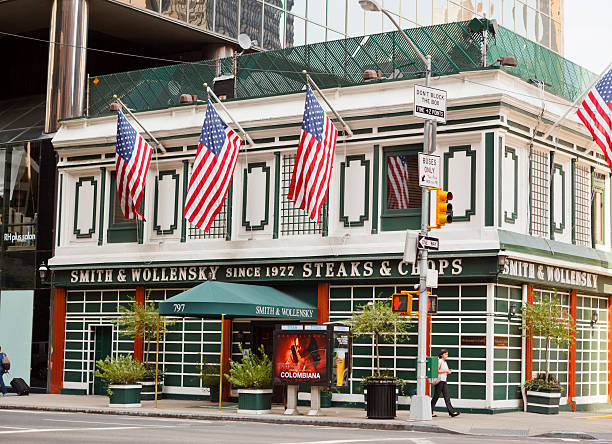The United States boasts an array of steakhouses, from major cities to the heartland, where premium cuts of beef reign supreme. In addition to independently-owned steakhouses run by renowned chefs, chain restaurants have also heightened their focus on quality. They aim to meet the expectations of a discerning dining public, ensuring that every dollar spent is worth it. Beyond variations in menus, formats, and ambiance, the key distinguishing factor for a steakhouse is indeed its dedication to quality, from the sourcing of ingredients to the art of preparation.
A lavish price tag doesn’t necessarily equate to elite quality. The essence of a superb steak transcends size or commercial growth. Much like the preference chefs have for specific steakhouse dishes, they also possess insights into what separates an exceptional steak from a mediocre one.
So, what defines an excellent steak? According to Scott Kroener, Executive Chef of Oak Steakhouse in Nashville, it’s the classic triumvirate of fine texture, marbling abundance, and a bright red hue. For Kroener, grain-fed beef takes precedence over grass-fed due to its superior tenderness and marbling. Certified Angus beef stands out for its well-defined quality standards, promising a reliable meat source.
In terms of cooking methods, Kroener champions broiling as his preferred technique. Broiling delivers consistent results with high-quality cuts when paired with a generous seasoning of kosher salt and fresh ground pepper. This technique prevents fat from dripping onto the flames, where it could burn and add a smoky flavor to the meat, enabling the beef’s pure essence to shine.
The role of fat in steak quality is underscored by Jeremy Shigekane, Executive Chef of Prince Waikiki, who highlights that the majority of the steak’s flavor is derived from fat. He recommends slow cooking, a good sear, and a touch of tallow for added flavor post-slicing. A quality steak, in Shigekane’s view, doesn’t need to be exorbitant, but it must be fresh, reflecting the care provided to the animal through minimal stress and a proper diet.
With the foundation of quality and care in place, the next critical aspect is the steakhouse’s cooking techniques. For Jimmy Pastor, Chef of Whiskey Joe’s Bar & Grill in Florida, attention to temperature and an appropriate salt dosage are pivotal. He emphasizes that the steak’s cut and fat content determine the ideal level of doneness. While medium-rare and rare are popular, the choice ultimately hinges on the cut and fat content.
Considering these factors, here are seven steakhouse chains that have mastered the art of delivering quality meat:
1. Morton’s The Steakhouse
Morton’s, though higher on the price scale, delivers exceptional value due to the quality of meat. The restaurant’s commitment to using Prime Beef, the highest grade from the U.S. Department of Agriculture, sets it apart. The meat undergoes aging for 23-28 days and is custom-cut according to Morton’s specifications.
2. Fogo de Chao
Fogo de Chao combines American steakhouse traditions with Brazilian influences. The steakhouse prioritizes sourcing meat in alignment with the Portuguese phrase “Respeito Pela Comida,” which signifies respect for food, animals, and customers. The chain partners with vendors who adhere to the Five Freedoms of Animal Welfare, ensuring that the beef is sourced ethically.
3. Ruth’s Chris Steak House
Ruth’s Chris stands out for its simplicity. The restaurant serves its USDA Prime cuts on sizzling 500-degree plates with minimal seasoning, allowing the meat’s quality to shine. The beef is sourced from reputable purveyors and adheres to the USDA’s guidelines for grading, quality, and ethical sourcing.
4. Steak 48
Steak 48 boasts in-house butchers who custom-cut 28-day wet-aged steaks, offering a diverse selection, from bone-in Kansas City strips to grass-fed New York strips. The restaurant sources most of its meat from farms in Michigan and Wisconsin and premium Wagyu beef from Mishima Reserve.
5. Shula’s Steakhouse
Shula’s Steakhouse is renowned for its SHULA CUT, an exclusive premium Black Angus steak sourced from Graham Angus Farms in Georgia. The steak adheres to strict USDA guidelines for grading, quality, and ethical sourcing. Members of the steakhouse’s management team oversee farm operations, ensuring adherence to high standards.
6. STK
STK offers Angus USDA Choice or USDA Prime beef sourced exclusively from the Midwest. The meat is either wet-aged for at least 30 days or available in a few dry-aged options. STK’s new STK Meat Market allows customers to enjoy the same quality meat at home.
7. Smith & Wollensky
Smith & Wollensky partners with Double R Ranch in Washington, a family-run cattle farm. The collaboration ensures the steakhouse’s premium meats come from cattle raised with care, compassion, and adherence to sustainability and quality standards. Double R Ranch USDA prime steaks are aged in-house for an additional 28 days to achieve optimal flavor and texture.
